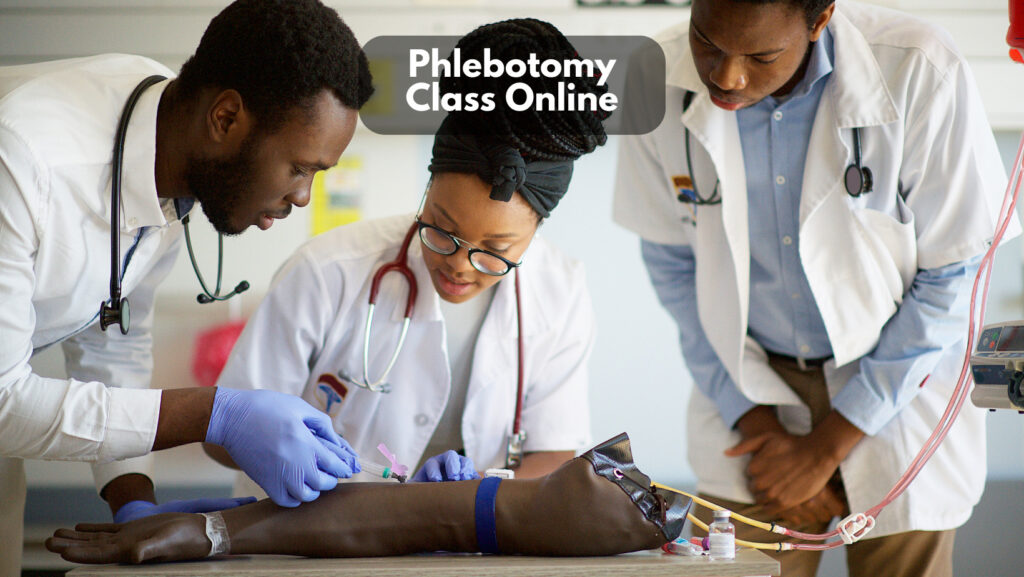Becoming a phlebotomist has many benefits, including job security and an average of $38,530 annual pay. The U.S. Department of Labor projects an 8% increase in phlebotomy technician jobs by 2032, making it an ideal field for learners. Students can pursue this career designation by taking a phlebotomy class online or attending on-campus studies. Our online class experts will handle your phlebotomy exams for guaranteed success. We explain what phlebotomy class online entails, covering the core topics, credit hours, examinations, certifications, and licensing.
Phlebotomy Class Online: Course Overview
A phlebotomy class online offers a flexible, shorter, and comprehensive avenue to acquiring skills in professional blood collection. A phlebotomist is a nursing care professional specializing in performing blood draws. Phlebotomists also transfuse blood, especially during donations. The online class combines theoretical phlebotomy concepts with practical aspects learned through instructional videos and virtual simulations. It prepares students for various certifications in phlebotomy by teaching techniques, safety protocols, ethics, and infection control measures.
Phlebotomy Class Online: Course Structure, Credit Hours, and Content Areas
The contact hours in a phlebotomy class differ depending on the course level and career designation. Most programs take 3 to 12 weeks of dedicated online learning. However, a learner must meet the 120-credit hour mark set by various states for licensing to get certified. The first 40 hours should go toward understanding the phlebotomy theories and principles, while the last 40 hours should go into clinical training. Learners must also undertake an externship laboratory training, taking at least 20 credit hours. Here’s a breakdown of the phlebotomy online class:
Medical Terminology and Intro to Human Anatomy
Classes on medical terminology and Intro to Human Anatomy delve into vocabularies used in the profession and related terms in human anatomy. These words include root words, suffixes, and prefixes that foster effective team communication. Further, the classes explain the major organs in the circulatory system. The students also cover anatomical considerations when drawing blood and locating ideal blood vessels.
Medical Records and Administrative Roles of a Phlebotomist
This class begins by introducing the administrative aspects which complement technical phlebotomy skills. Additionally, it addresses accurate documentation of blood-related records necessary for maintaining precise and confidential specimens. Executive roles explain appointment scheduling, coordinating professionals, and managing inquiries. Other tasks include insurance billing, recording standards and ethics, and coding procedures. The classes focus on preparing learners to become well-rounded phlebotomists. Ultimately, they cover the role of efficient record-keeping in continued phlebotomy and fostering effective communication to safeguard patient safety.
The Human Body System
Classes on the human body system build upon the human anatomy, covered in the introductory part. It digs deeper into the human body’s anatomical and physiological intricacies and their bigger role in blood collection. The sessions focus on the circulatory, urinary, and respiratory systems. They emphasize the interdependence among the three methods in blood generation, circulation, and phlebotomy practices. As the course progresses, students learn about the impacts of venipuncture and specimen collection on the human body system. They include recognizing medical conditions influencing blood draws and the technical skills required to navigate potential challenges. The Human Body System is explained further in the class cell and tissue anatomy and pathology.
Patient Preparation and Examination
The phlebotomy class online for patient preparation and examination explains the essentials of proper handling before, during, and after drawing blood. This class begins with exploring effective communication for developing rapport. The students learn about consent, patient concerns, and fostering a comfortable and supportive environment here. Further, the class delves into technical skills, such as how to instruct patients during venipuncture. It also addresses potential complications and factors influencing patient preparation, including medical history.
Drawing Blood and Blood Testing
This class entails practical aspects of phlebotomy. The students learn various venipuncture techniques and how to identify the best blood collection method. Learners must also be adept at locating blood vessels using hands-on phlebotomy tools. The class also addresses safety protocols, patient hygiene, and minimizing discomfort when drawing blood. As the course progress, the class delves into laboratory blood testing procedure, sample handling, and proper labeling. It ends with efficient recording, transporting, and specimen management.
Phlebotomy Class Online: Examination, Certifications and Licensing
Learners have six phlebotomy certification options to pursue after a phlebotomy online class opens doors to various career designations. Each designation has a special examination one must pass to be licensed. They include:
- Certified Phlebotomist Technologist (CPT)Certification: Requires 160 hours of lecture and 200 hours of practical externship. Learners must pass the CPT exam to attain licensure.
- Phlebotomy Technician Certificate (PTC) Certification: Requires a 1-year part-time practical phlebotomy technical skill. Learners eligible for the PTC exam must also have at least 75 venipunctures and five fingersticks.
- The Phlebotomy Technician (PTC) Certification is provided by the American Allied Health, unlike the Phlebotomy Technician Certificate (PCT), provided by the American Medical Certification Association. The PCT exam requires learners to provide proof of one year of work experience.
- The Phlebotomy Technician (NCPT) Certification: Provided by the National Center for Competency Testing (NCCT). Eligible learners must provide a 1-year proof of training or an
- Certified Phlebotomy Technician (CPT) Certification: Provided by the National Healthcareer Association. Eligible applicants must demonstrate to have taken at least 30 successful venipunctures and ten capillary sticks. Alternatively, they must submit a 1-year proof of supervised work experience.
- Phlebotomy technician (PBT) Certification: A PBT examination requires learners to complete at least 100 successful venipunctures. The PBT certification is renewed every three years.
Get Comprehensive Phlebotomy Class Online from Top Experts
Reports by the Bureau of Labor reveal that Phlebotomy is growing and will continue to grow more than the average of all occupations. Jump into this promising field by registering for a phlebotomy online class today. Contact our experts for Phlebotomy exam help today to begin your successful journey to becoming a licensed phlebotomist with minimal hurdles.





Pingback: Phlebotomy Online Classes: Sections, Course, and Certification